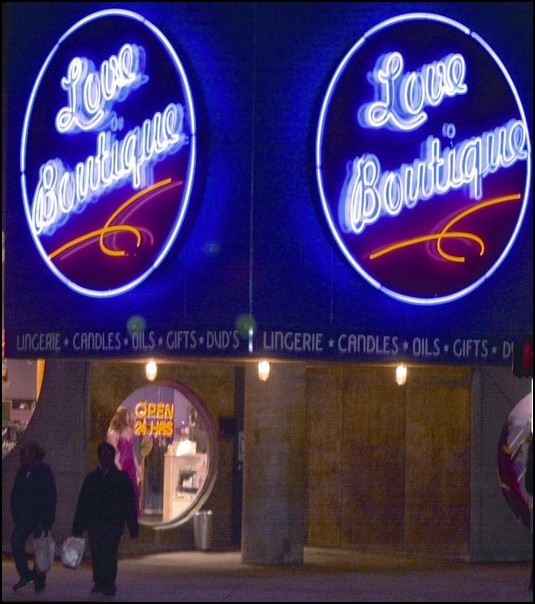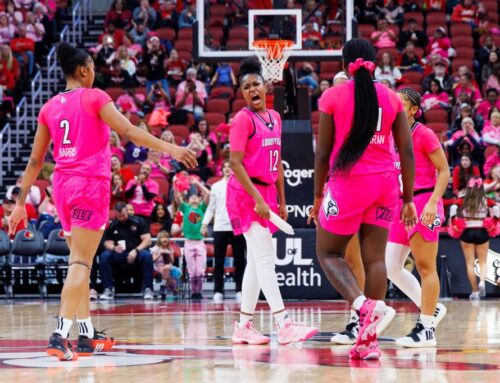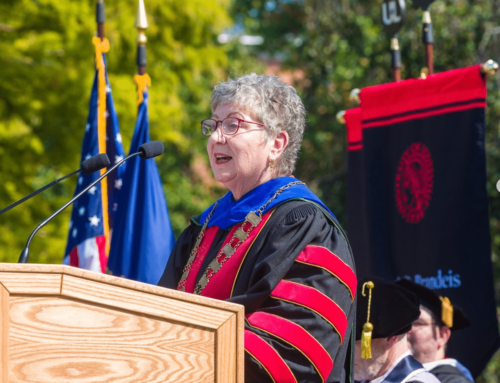In the 100 block of West Jefferson Street stands a business many could do without. The big, round sign announces it is the home of the “Love Boutique,” an infamous adult book store. But ask anyone who’s lived or worked near downtown for a while, and what’s in the building now barely registers.
To many, the building is still known as the old City Blueprint building. The concrete structure, resplendent with large round windows and a large cube on the corner, once housed a blueprint printer.
Deborah Richards of the Louisville Metro Department of Inspections, Permits and Licensing remembers when the change was made. The sign was a major issue. It was the City Blueprint logo, a large circle with “CB” inside. The circle and the letters were impressed into the concrete — a permanent sign that the Love Boutique wanted to cover up.
Richards talked the business owners into “maintaining the integrity” of the sign by covering it with another round sign. Underneath, the CB logo remains.
The imprinted logo was the work of Jasper D. Ward, an architect born in 1921. Similar logos can be found on his works throughout the city, including the Okolona Elementary School and Mike Walsh’s Liquors downtown.
Concrete is a heavy medium, but it’s the one Ward worked in most often. His buildings are not fluted spires or angled glass; many of them are merely parking garages.
But even parking garages can win awards. Ward’s garage at the Riverfront Belvedere Plaza won the seventh annual Award for Excellence from the Federal Highway Administration in 1974. According to the newly published Louisville Guide, written by Dennis Domer, Gregory Luhan and David Mohney about Louisville architecture, Ward “emphasized geometric qualities in the public areas of the garages to give them a sense of place and life.”
Ward’s approach to architecture was, according to his eldest daughter Tika Ward, that “form follows function.”
“What held the building up was part of the design,” she said. The Jewish Doctors Office Building is one her favorites. “It really symbolizes Jasper’s approach to architecture.” The building, located at 250 E. Liberty St., won the Portland Cement award after its construction.
The Jewish Doctors Office Building is supported by concrete structures that resemble tuning forks, according to Tika and her brother Mike. Both named it as their favorite building by their father.
“It’s aged really well,” Mike Ward said. “It just continues to look good.” At 10 stories, it is also the largest building Ward designed.
“Jasper D. Ward’s ability to make a most banal building type — the anonymous office building — into an interesting work of architecture is testimony to the talent of this under recognized architect,” according to the “Louisville Guide” about the Jewish Doctors Office Building.
Architecture became a major part of Ward’s life the day he left MIT, Mike Ward said.
“Except for his family, architecture was his entire life,” he said.
Upon graduating from MIT, Ward spent some time working at an architecture firm in New York. In 1956, he got a job at GE as part of a program to design kitchens around their appliances. He picked up his wife and three children and moved to Louisville.
Six months later, GE fired Ward and ended the program. Ward returned with his family to New York — but came back to Louisville six months after that.
Once settled in Louisville, he became what Mike and Tika called a “pioneer of Main Street.”
“All of his offices were on Main Street,” Tika Ward explained. Jasper Ward moved into an office at Third and Main Streets in 1958, before all the development made it a good place to be, Mike Ward said.
Ward, according to the Louisville Guide, had one of the six leading architectural firms in the city between 1950 and 1970. He designed the Kentucky School for the Blind, the Riverfront Plaza building, Portland Elementary and numerous other civic projects over those years. His designs also included a number of interior redesigns — including a restoration of Grawemeyer Hall in 1975, when it was still known as the “administration building.” In 1990, he was part of the architectural team that designed the Swain Student Activities Center.
His greatest gift, though, was “being able to draw out the best in young architects,” Tika Ward said. As a visiting art critic at the University of Kentucky in the 1960s, he was able to work with a number of students. He was also “big on bringing in women and African-Americans” to the field, she said.
Mike added that his father was “a really nice guy,” and that even business contacts Ward hadn’t worked well with still liked him personally.
Ward was born in 1921 in Flemington, N.J., and died in 2002 in Louisville. His structures, from parking garages to schools, will remain standing for decades as testimony to what can be done with a little concrete.






